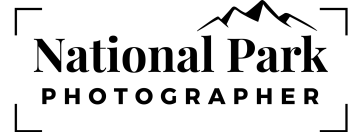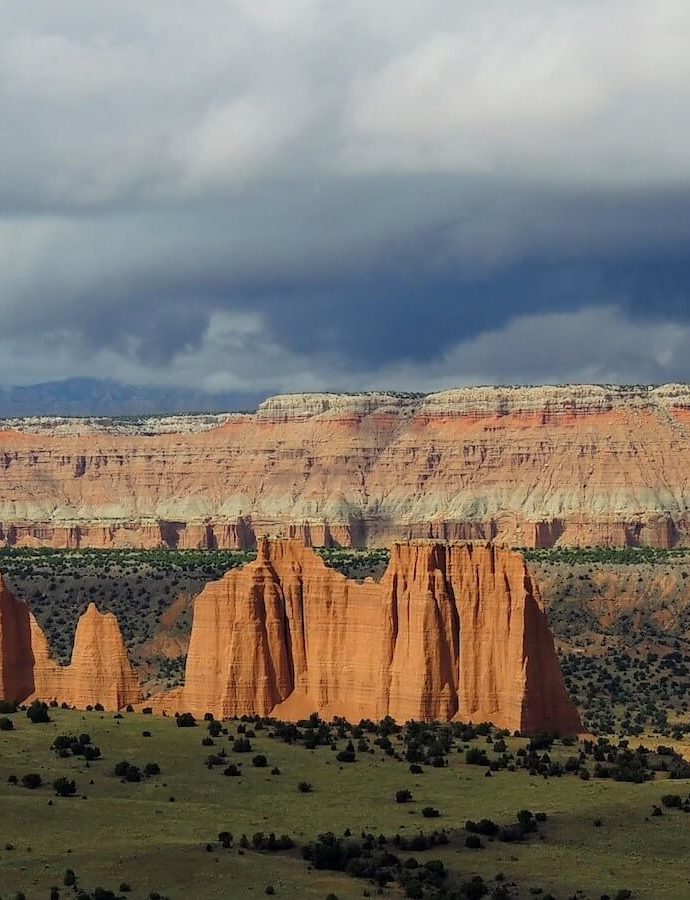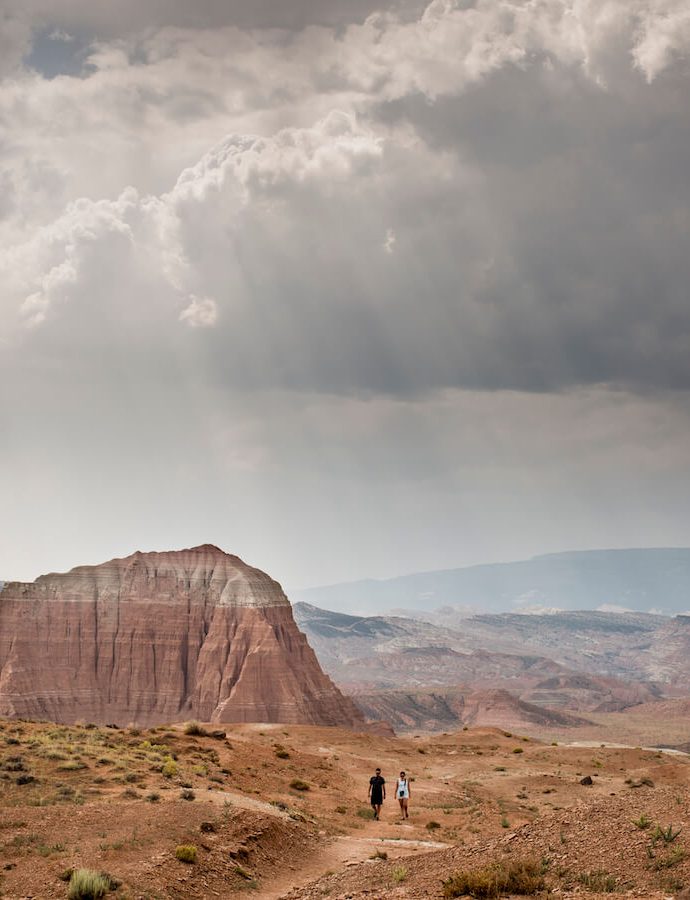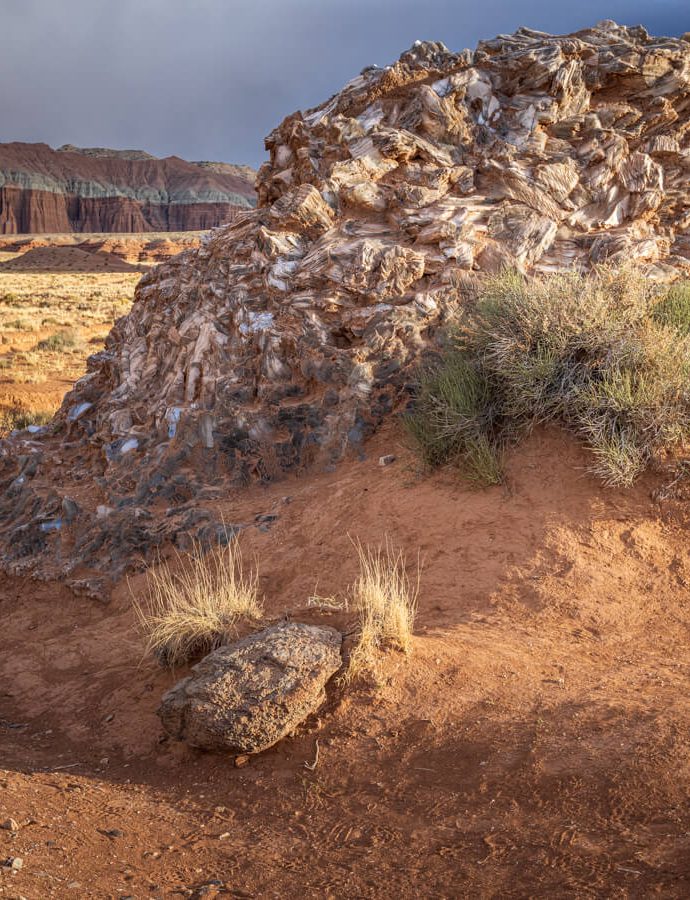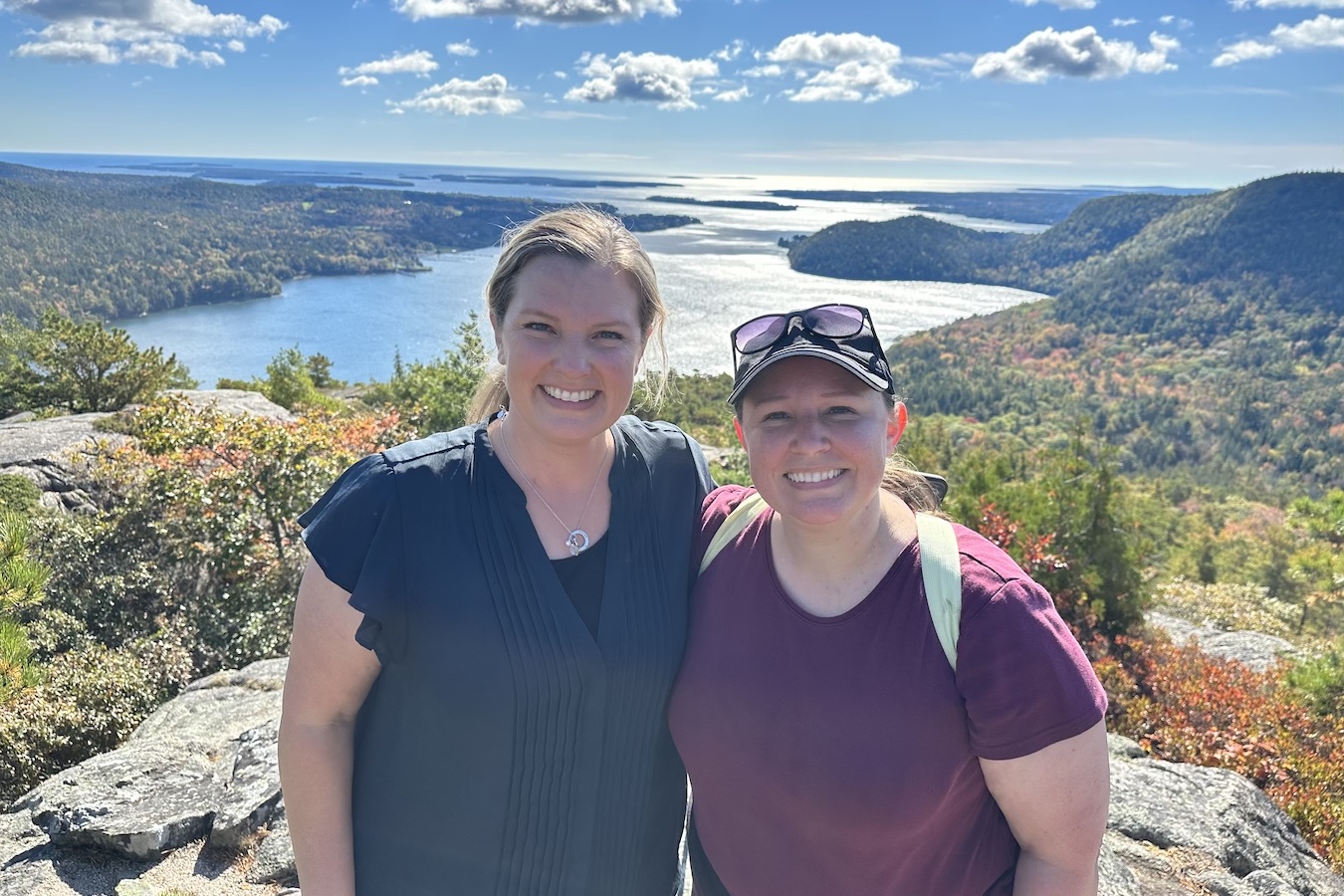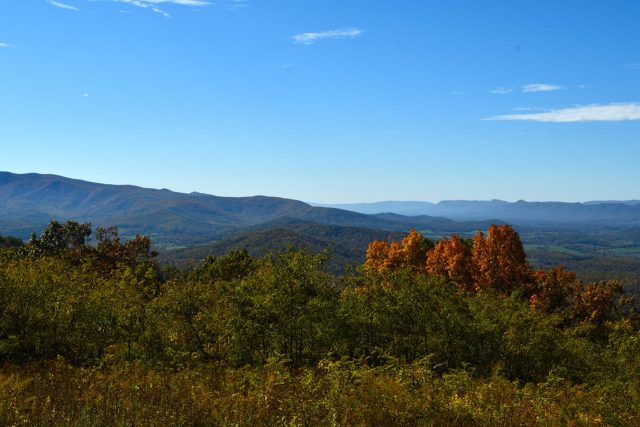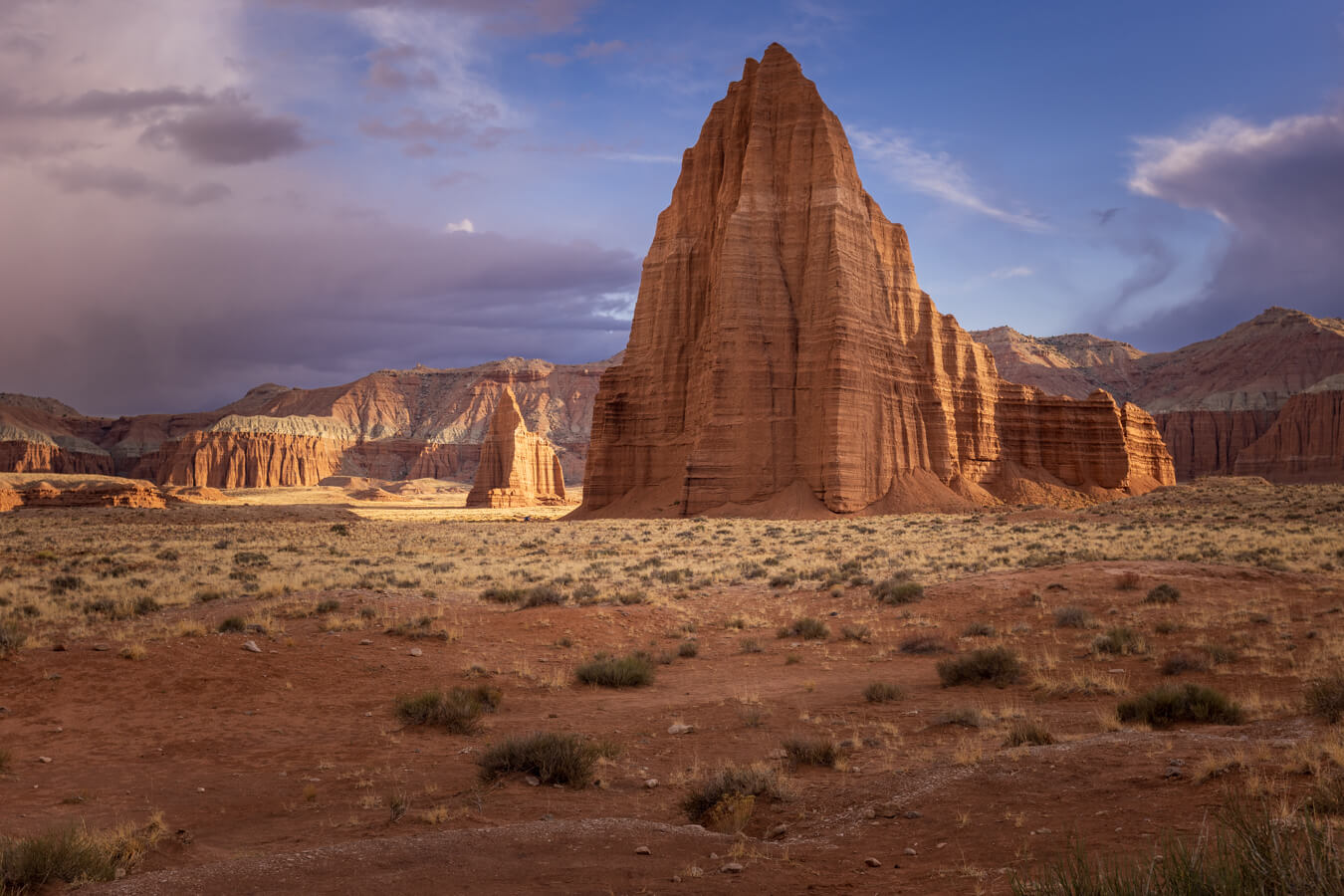
Length: 0-0.8 mi (0-1.3 km)
Elevation Gain: Minimal
Route Type: Out and Back
Difficulty: Easy
The Temples of the Sun and Moon are located in the Cathedral Valley District, also known as the North District, in Capitol Reef National Park. The most prominent geologic feature in this area is the Temple of the Sun. This giant, 402 ft (123 m) tall monolith is “composed of the earthy, buff-pink Entrada Sandstone.” (NPS) Close to the Temple of the Sun, you will also see the 285 ft (87 m) monolith known as the Temple of the Moon. Did you know there are also formations known as the Temples of the Stars? This is one location in Capitol Reef National Park where photos don’t do it justice. I loved seeing and photographing these formations in person and wish I had more time to fully enjoy them. Keep reading to learn how to access and photograph the Temples of the Sun, Moon, and Stars!
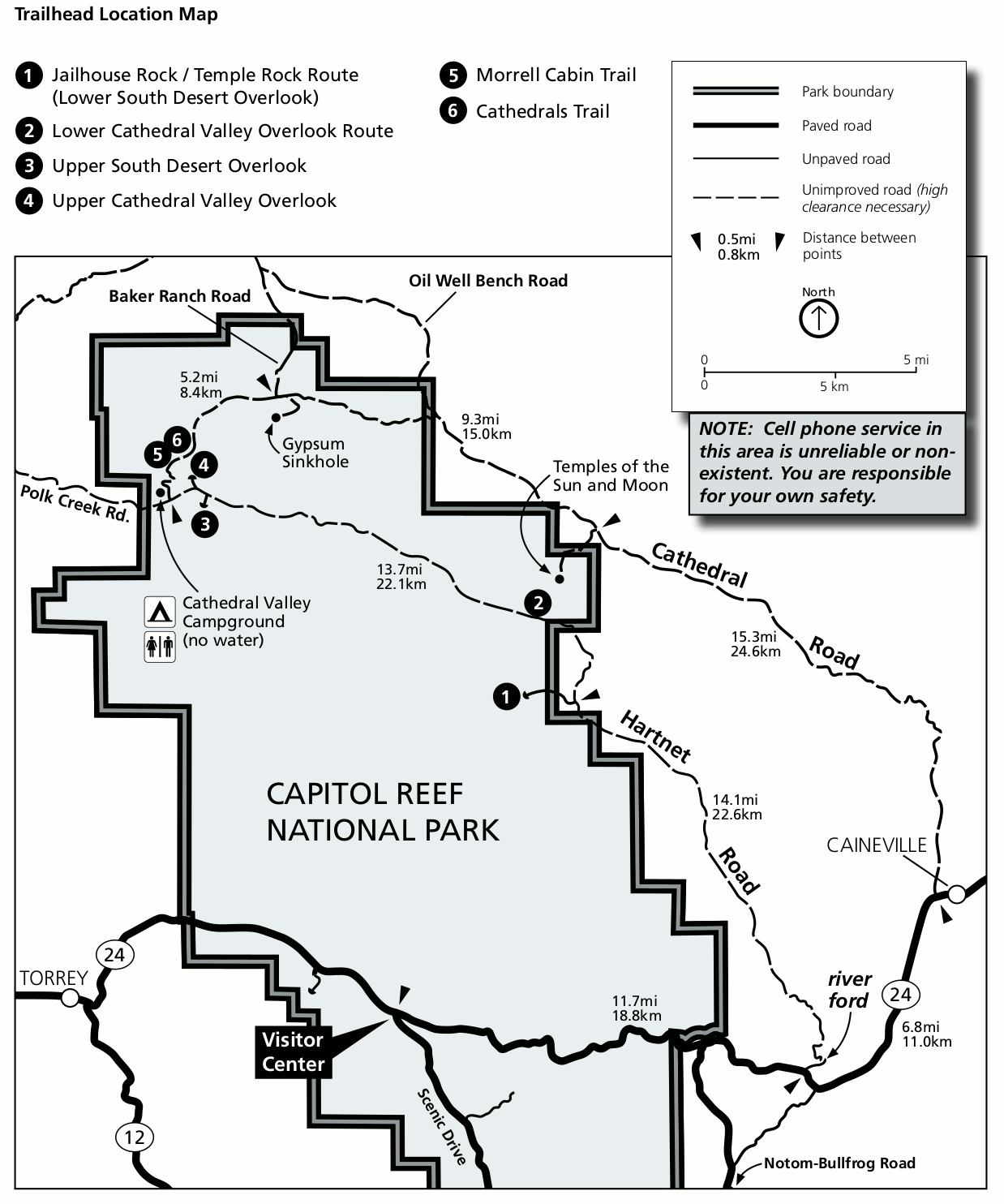
Accessing the Temples of the Sun and Moon in Capitol Reef National Park
Starting Location: Temple of the Moon Road, Utah
GPS (DD): 38.459397, -111.175655
There are a few different ways to access the Temples of the Sun and Moon. All methods will take you to unpaved roads that will have varying conditions depending upon the time of year and current weather. A high-clearance, 2WD/4WD vehicle is recommended. (This does not include ATVs/UTVs, even street ones, which are not allowed in Capitol Reef National Park.) To make your trip easier, there are jeep rentals and photography tours based in Torrey, UT that I highly recommend.
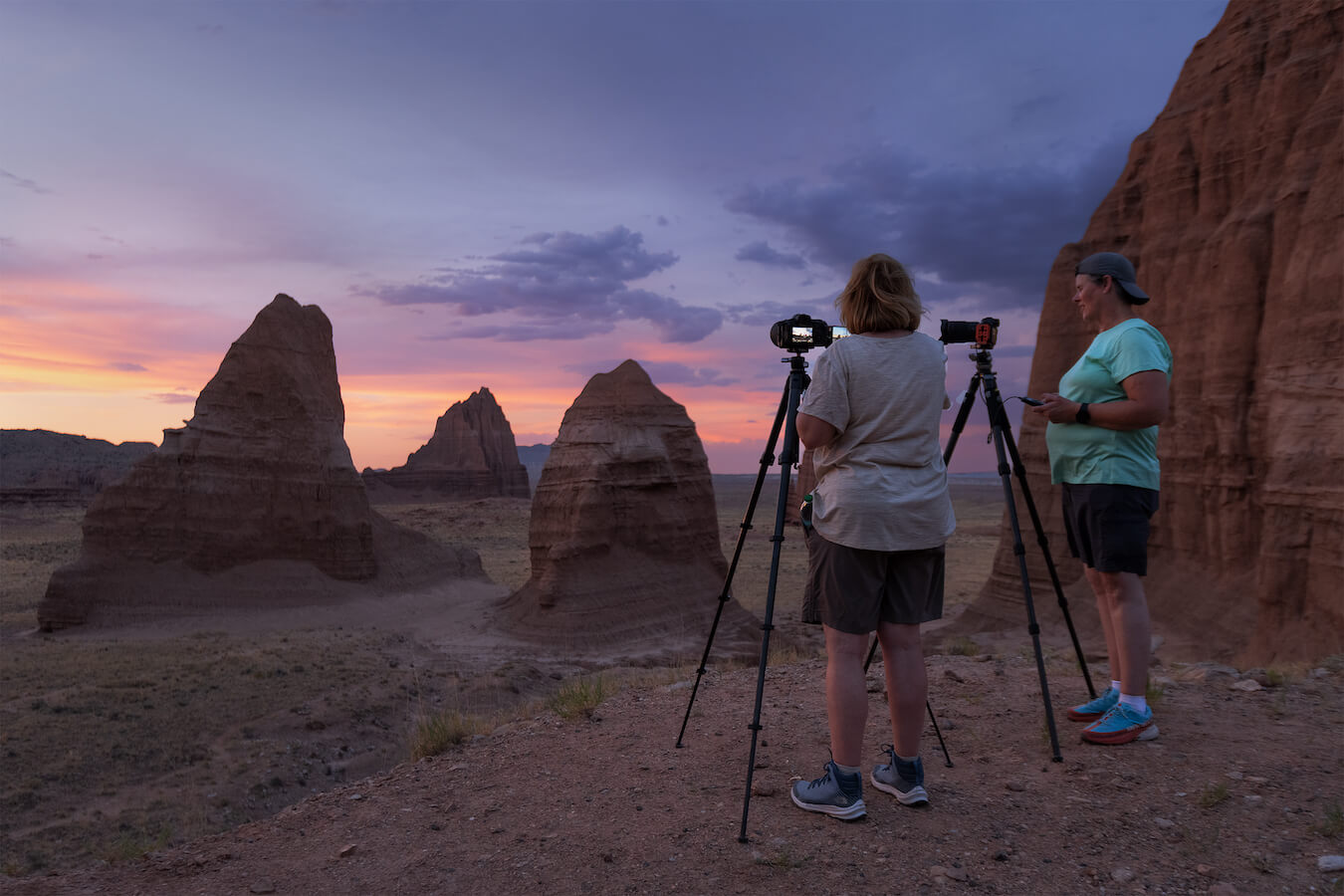
Be sure to check the current road conditions before venturing out. Some of the roads can become impassable when wet. You can ask at the Visitor Center, check the current conditions at the NPS website, or call 435-425-3791 (press #1 for information and then #4 for current road conditions). This phone number will also give you access to the current weather conditions and the harvest and blossom schedule for the Fruita orchards.
The most popular way to experience Cathedral Valley is by taking the Cathedral Valley Loop drive in a clockwise direction, beginning on Hartnet Road. The entire loop will take you 6-8 hours to drive and explore, so if you choose to go this route, plan accordingly.
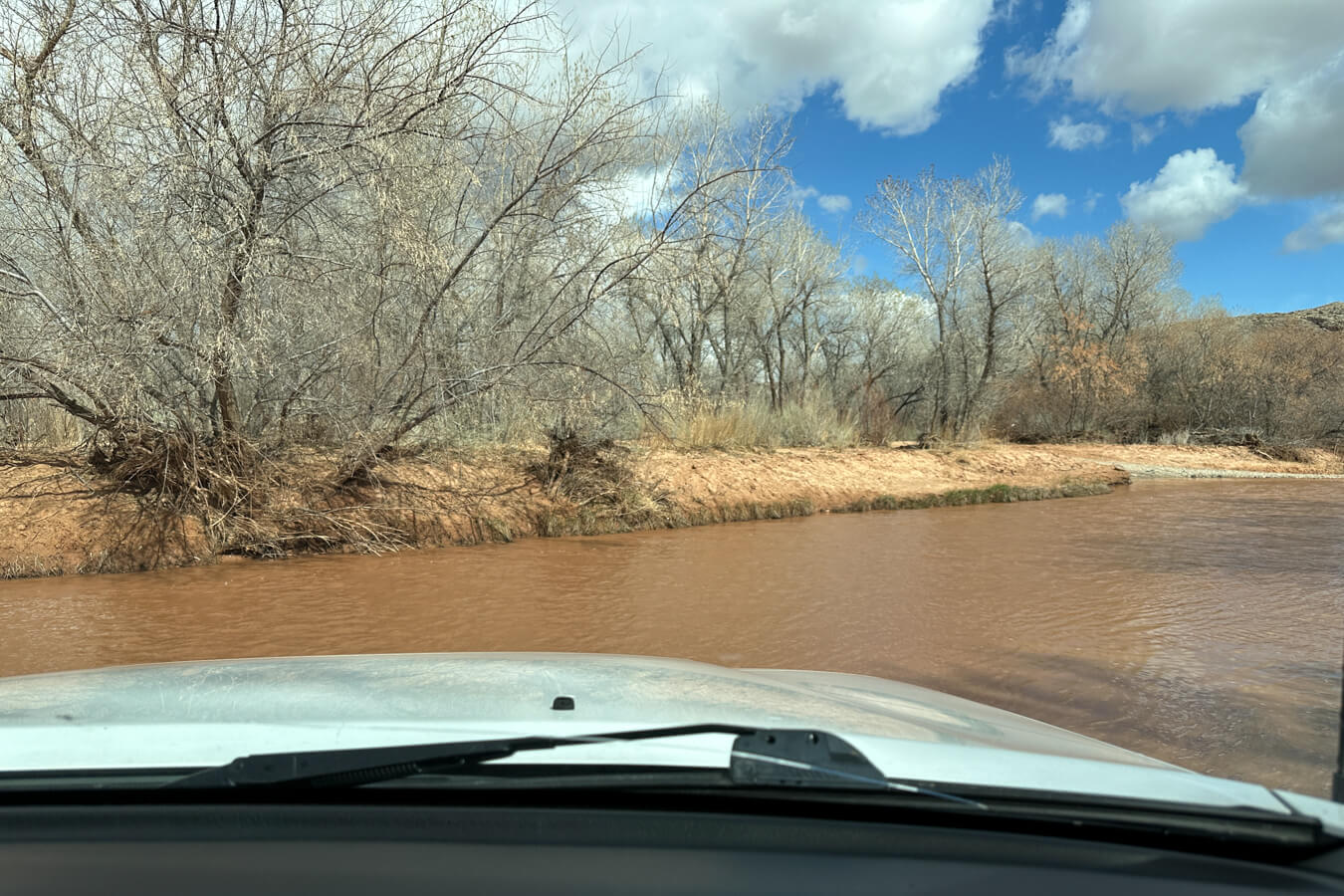
The Hartnet Road entrance requires you to drive a short distance in the Fremont River. You read that right. Not over…in. There is no driving bridge that crosses the Fremont River on this route. (Here is a link to a map for the Hartnet Road River Ford.) As the water levels vary, you will want to make sure to check the above references for the current conditions. Once you ford the Fremont River, after about 8.5 mi (13.68 km) you will arrive at the Bentonite Hills. While not technically in Capitol Reef National Park, they are a beautiful location and well worth photographing.
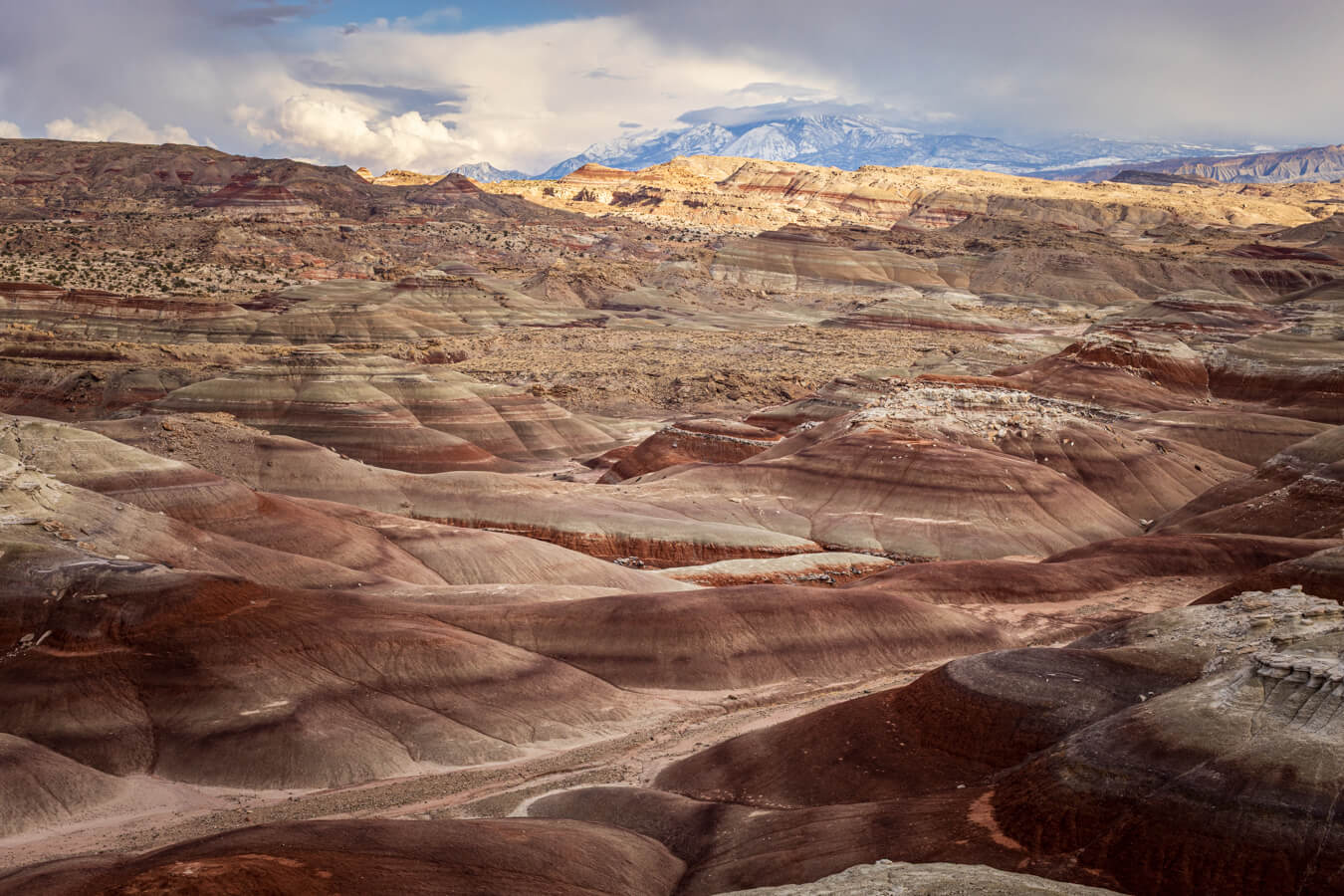
From there, you can continue to drive the loop. You will pass by several overlooks and trailheads, including the Upper Cathedral Valley Overlook and Gypsum Sinkhole. (This article from Dirt in My Shoes gives a great overview of the entire loop with pictures!)
The Temples of the Sun and Moon are located on the other side of the loop, accessible via the Temple of the Moon road. As you approach these monoliths, you will see the Glass Mountain formation. This 15 ft (4.57 m) tall geologic wonder is so beautiful. It is formed from large selenite (gypsum) crystals that pushed their way up through a fracture in the earth. This is a very unique and protected formation. “As you visit Glass Mountain, please remember that collecting of any kind is prohibited in all national parks.” (NPS)
You will be able to see both the Temple of the Sun and Temple of the Moon from Glass Mountain. This is also a great vantage point to photograph the Temple of the Sun. From here, you can drive closer to the Temple of the Moon. There is a small pullout area where you can park your car and then you can hike around from there. Once you have finished photographing the area, head back out to Cathedral Road to finish the loop.
On Cathedral Road, you will pass by the Morrison Formation (made with similar components as the Bentonite Hills) and will ultimately reach the main, paved road, UT-24 W. Turn right on UT-24 W if you want to return back to Capitol Reef National Park.
If you don’t have 6-8 hours and just want to see the Temples of the Sun and Moon, an alternative route is to drive the 17.1 miles (27.5 km) each way from Caineville up Cathedral Road and then left on the Temple of the Moon road. The road conditions will still vary on this section of road, and you will still need a high clearance vehicle, but you won’t need to cross the Fremont River and it will cut your travel time down immensely.
You can also access Cathedral Valley from the north via Poll Creek Road, Baker Ranch Road, or Oil Well Bench Road depending upon where your starting location is. (Check the National Park website for complete driving distances from each location.)
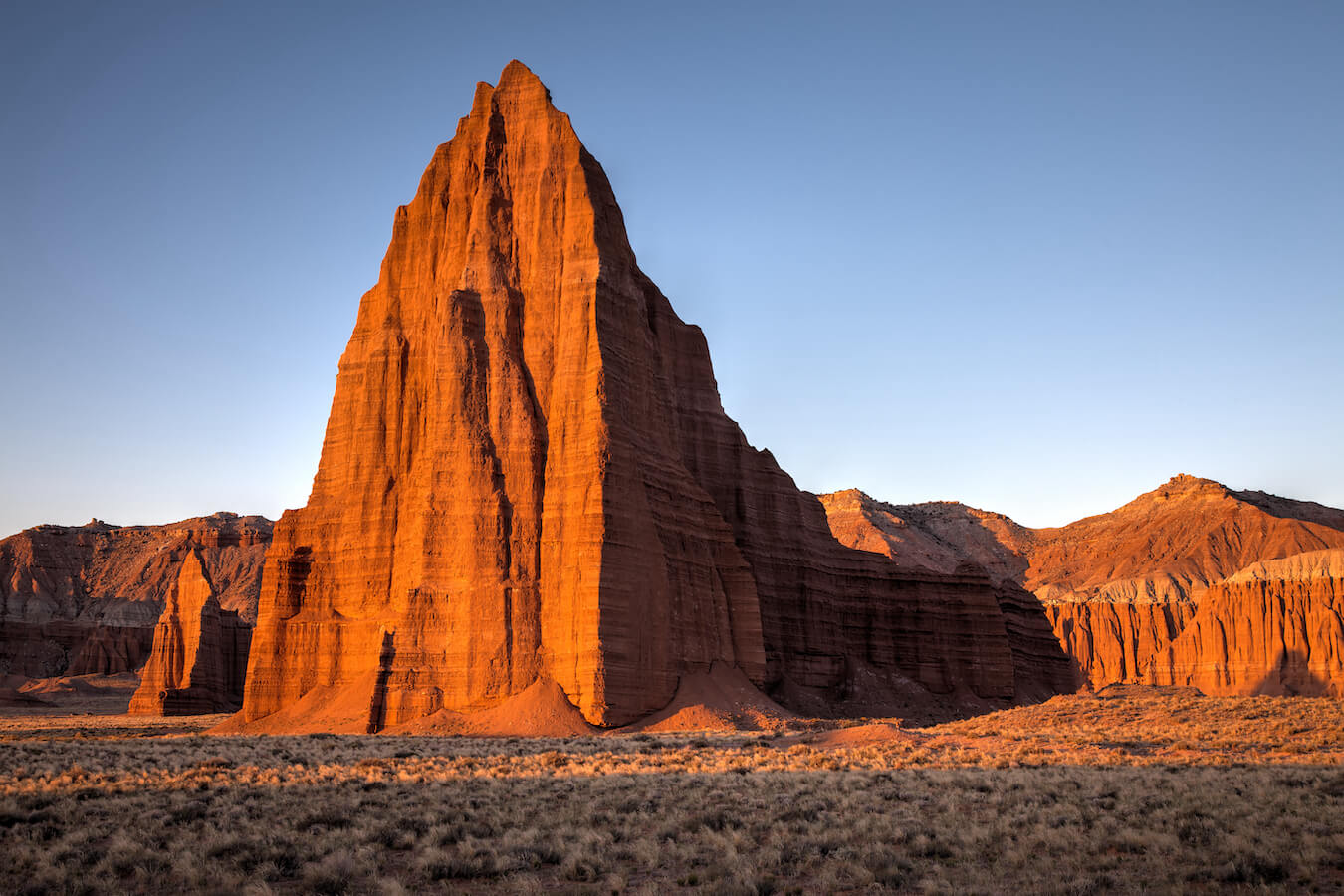
Driving and Hiking Tips at the Temples of the Sun and Moon
Cathedral Valley is located in a remote part of Capitol Reef National Park. As such, you need to use extreme caution when planning your trip. Here are some tips!
Be Prepared for the Unexpected
Due to its remote location, Cathedral Valley is less visited than the other areas in Capitol Reef National Park. Because of that, you need to be prepared for constantly changing conditions as well as the possibility of becoming stranded. While not always the case, it is possible to come across a muddy or sandy area that will be difficult for you to navigate, especially after spring and summer rains or winter snow. Depending upon the weather, some areas may become impassable. Remember to ask a park ranger at the Capitol Reef Visitor Center, or call the main number, 435-425-3791, for the current conditions. (Press #1 for information, and then #4 for current road conditions. For weather conditions press #3.) (NPS)
I personally wasn’t comfortable fording the river and driving through Cathedral Valley the first time we went, so we booked a photography tour with Capitol Reef Photography Tours. When we went in early April, the Fremont River swelled due to recent snowmelt and rain. We almost turned back. Thankfully, Hunter did a great job navigating the river and checking in with other touring companies ahead of time to ensure our safety. While we didn’t do the entire loop (there is a rough road not on the above map that crosses over to the other side of Cathedral Valley), we were able to see the Bentonite Hills and Temples of the Sun, Moon, and Stars just in time for sunset. It was SO beautiful and totally worth it. That said, there was a lot of mud near the Bentonite Hills when we went. Having a shovel with us was useful for scraping off our shoes. A shovel can also help you get your car out of a sticky situation.
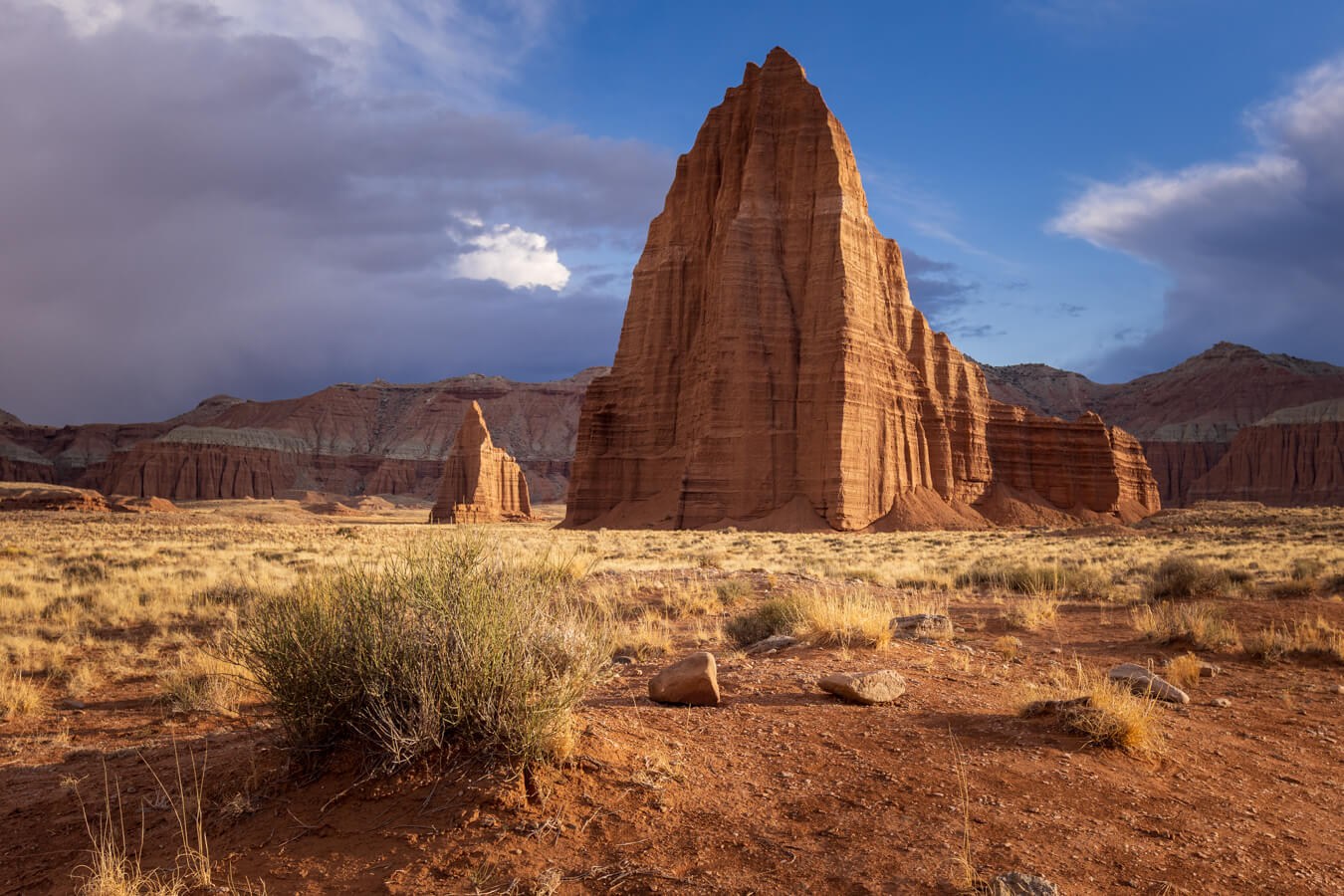
Recommended Emergency Supplies in Cathedral Valley
Whenever you are hiking or off-roading, it is always a good idea to bring extra emergency supplies with you as help may not come for several hours to several days. Here is a small list of recommended items to bring when you visit the Temples of the Sun and Moon:
- Water
- Food
- Gas
- Extra Clothing/Layers
- A Shovel
- Toilet Paper/Wipes and Bags (Remember to leave no trace ;))
- First Aid Kit
- Map
- Additional Emergency Supplies (Click here for a complete list of our recommended photography and hiking gear)
There is no potable water in Cathedral Valley and there are no bathrooms, aside from a pit toilet found at the primitive campsite on the north end of Cathedral Valley. Bring more water than you think you need. If you are not comfortable going to the bathroom outside, you may also want to bring a small pop-up tent and portable toilet with you.
Be Prepared for Limited to no Cell Service
There is limited to no cell phone service in Cathedral Valley. Because of that, it is a good idea to let someone know where you are going as a backup in case something happens. Even a screenshot text to a friend or family member prior to entering the area would work.
It would also be helpful to have some sort of map or GPS-tracking device to help you navigate the trails and roads. Even when you don’t think you will get lost, if the trails or roads are poorly marked, it is a possibility. Some GPS trackers, like the Garmin inReach and the Garmin inReach Mini, can also communicate your location to others. At a minimum, have a printed copy of the maps and hiking trails or download them to your phone.
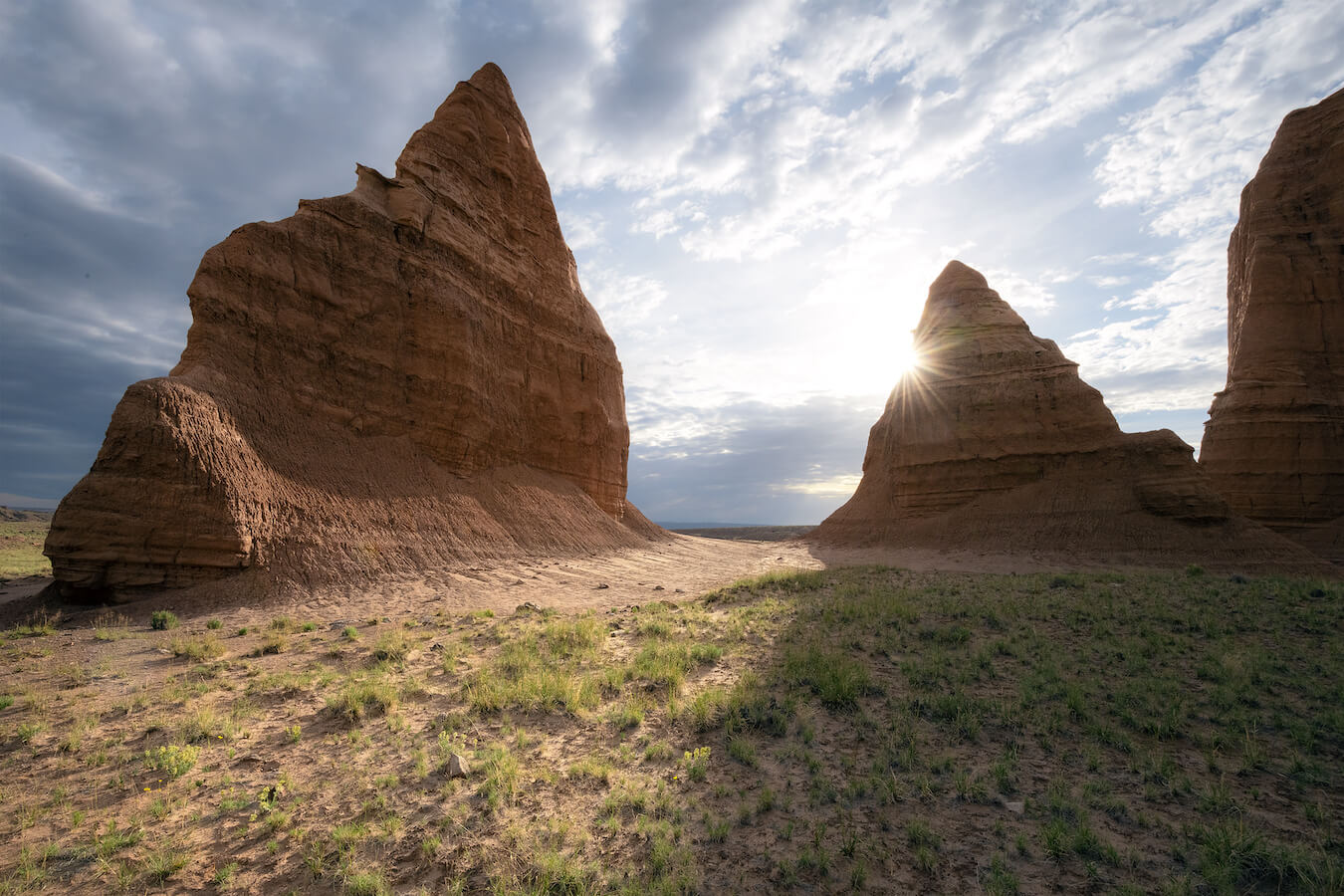
Best Time of Year to Visit the Temples of the Sun and Moon
Cathedral Valley is open year-round. Due to extreme heat in the summer and freezing temperatures in the winter, spring and fall are generally considered the best times of year to visit and photograph the Temples of the Sun and Moon. The roads are generally regraded in Cathedral Valley just after the snow melts in the early spring. Going at this time of year will allow for the smoothest possible driving conditions. Our tour guide, Hunter, told us that the roads were optimal for driving when we went in early April. That said, the temperature and weather can vary greatly in the spring. We had snow, rain, freezing temps, and then warm sun during our trip to Capitol Reef. This created a beautiful contrast against the red rock, but also delayed our trip into Cathedral Valley by one day due to poor weather conditions. Be sure to check the local weather forecast before heading into Cathedral Valley.
Be Respectful of the Area and Ecosystem
As you explore the areas surrounding the Temples of the Sun and Moon, be mindful of your surroundings and try to use already worn walking paths as there is delicate cryptobiotic soil, which is the lifeline of the desert. It is illegal to take home any samples or to climb on the Temples of the Sun and Moon. Camping is also not allowed, except in designated areas, and no pets are allowed in the backcountry of Capitol Reef National Park, so plan accordingly (NPS). Showing proper respect to our National Parks can help ensure that they will be around for a very long time.
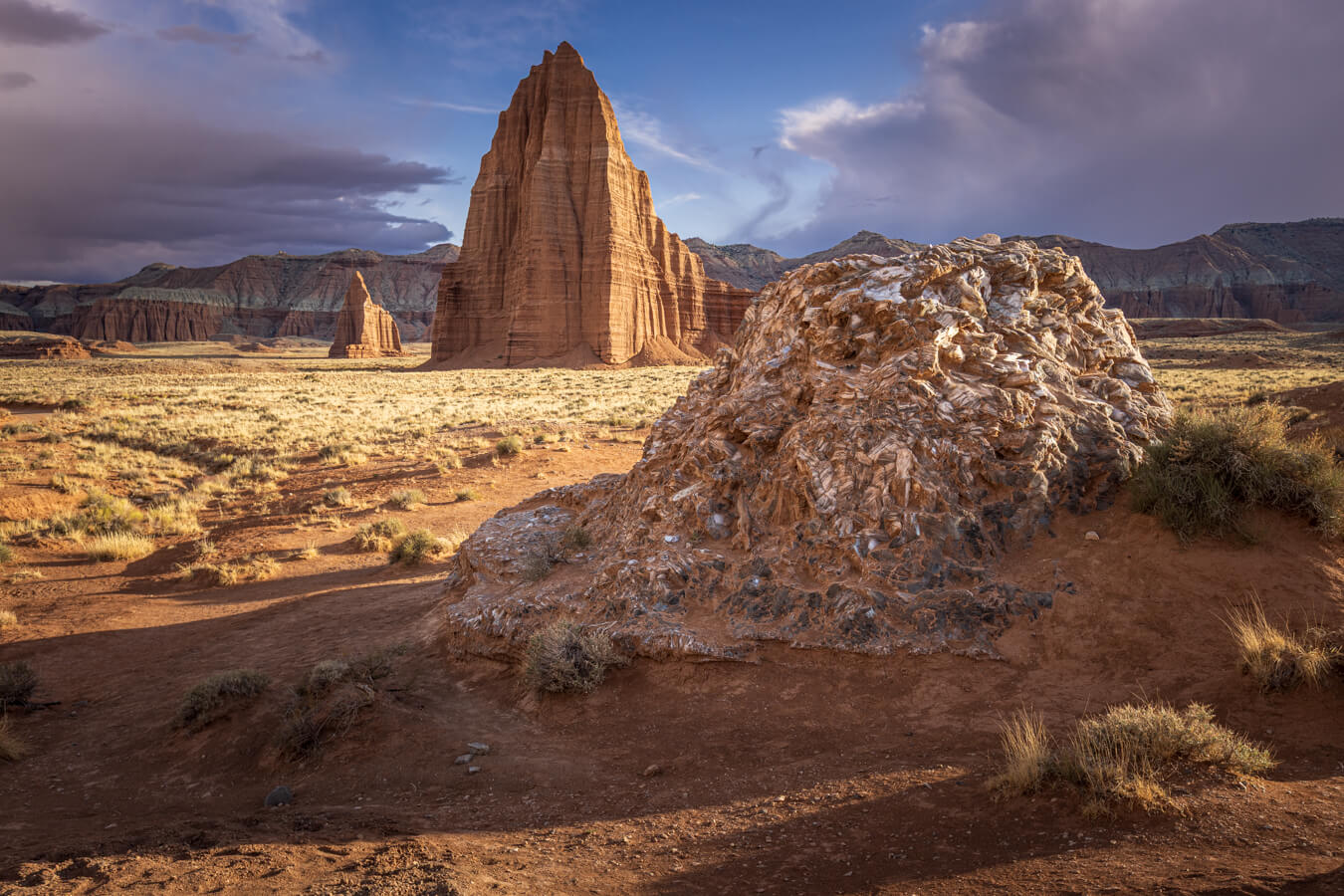
Top Photography Locations and Points of Interest at the Temples of the Sun and Moon
Once you arrive at the Temple of the Sun, take your time to explore the area, being sure to be mindful of new growth and fauna. You can photograph the Temples of the Sun and Moon from Glass Mountain or drive closer to get different vantage points. When driving around, make sure to stay on the established dirt roads. If you want to watch the sun set behind the distant cliffs, the Glass Mountain side of the road will offer that viewpoint. Both sunrise and sunset will offer beautiful lighting opportunities as the low sun illuminates different sections of the Temples of the Sun and Moon. Please note that drone photography is not permitted anywhere within Capitol Reef National Park.
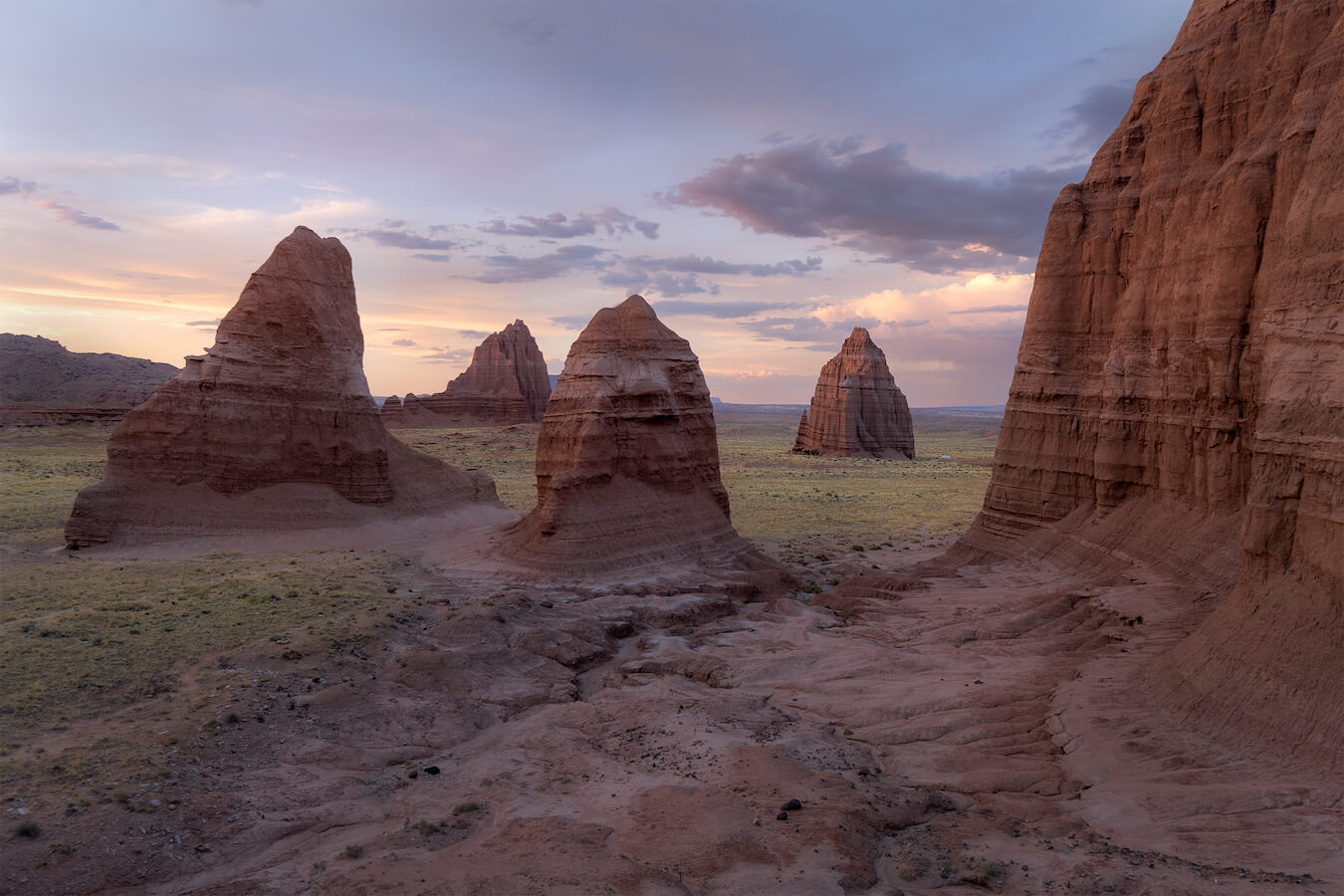
Photographing the Temples of the Sun, Moon and Stars
Another great photography vantage point is from the other side of the Temples of the Sun and Moon. If you park near the Temple of the Moon, there is a dry wash that you can follow and then a small, skinny trail to your left. This will take you to a mound of earth that you can climb up on to view the Temples of the Stars. If you position yourself just right, you will be able to see not only the Temples of the Stars, but also the Temples of the Sun and Moon perfectly framed in the distance. The setting sun will illuminate the side of the Temple of the Moon, creating drama and depth. (GPS (DD) 38.441078, -111.195442)
One thing I learned from Hunter on my Capitol Reef Photography Tour was to take my time and wait. As the sun set, I watched as the clouds morphed and shifted, creating different colors and moods. It was a great location and a memory I will never forget. I also learned the importance of walking only where others have walked. Once compressed, the cryptobiotic soil can take anywhere from several years to several decades to recover. Hunter was respectful to both our group and the earth.
Another popular vantage point in this location is a little further to the right as you hike from the Temple of the Moon. (GPS (DD) 38.441819, -111.195292) This vantage point frames the Temple of the Moon in-between the Temples of the Stars and is another beautiful location both at sunrise and sunset. (Oceanus Adventure)
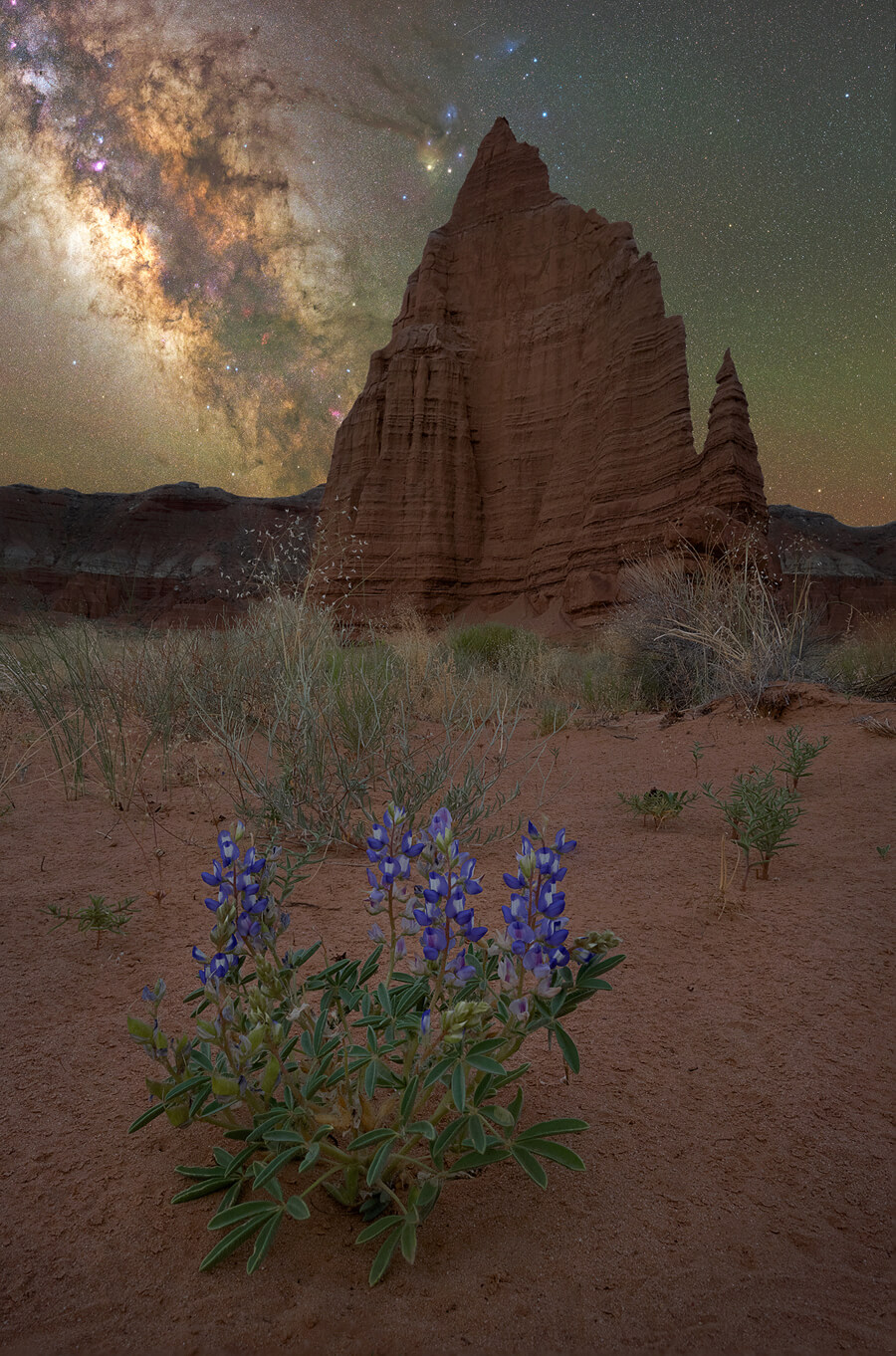
Astrophotography at the Temples of Sun and Moon
Astrophotography is amazing at the Temples of the Sun and Moon, as Capitol Reef National Park is a designated International Dark Sky Park. As such, light painting is not permitted. (NPS) That said, as you can’t camp at the Temples of the Sun and Moon, the closest lodging is the primitive Cathedral Valley Campground (located approximately 1 hr. 2 min. away) or the Cathedral Valley Inn (located approximately 1 hr. 14 min. away). Be prepared to be tired and to navigate rough road conditions in the dark.
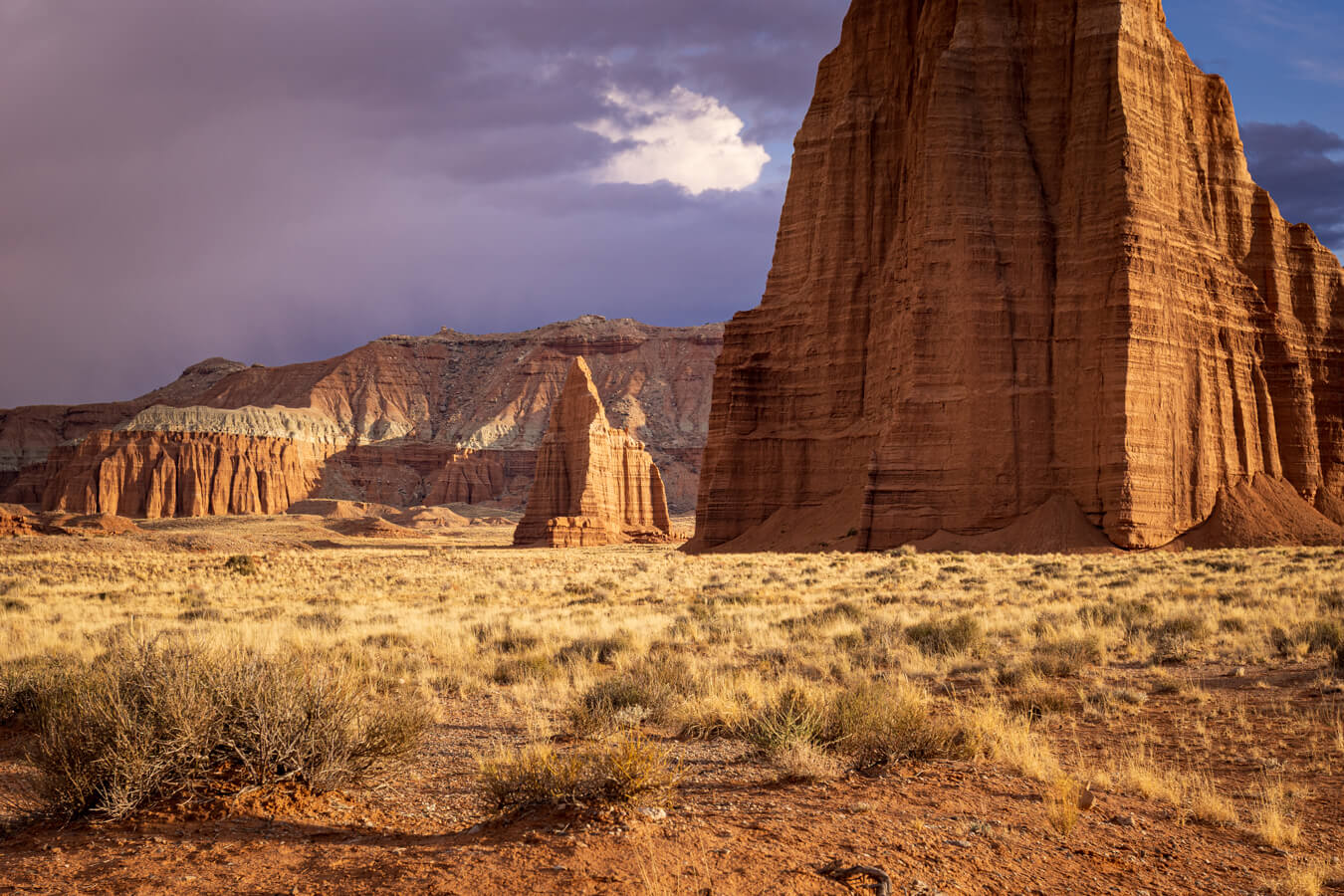
Closing Remarks
Overall, we loved our time in Cathedral Valley at the Temples of the Sun and Moon. Having a guide to help us navigate it the very first time was priceless as I wouldn’t want to subject my car to the dust and uneven terrain. I loved seeing the diversity in the landscape in addition to the many different formations. I would definitely go again.
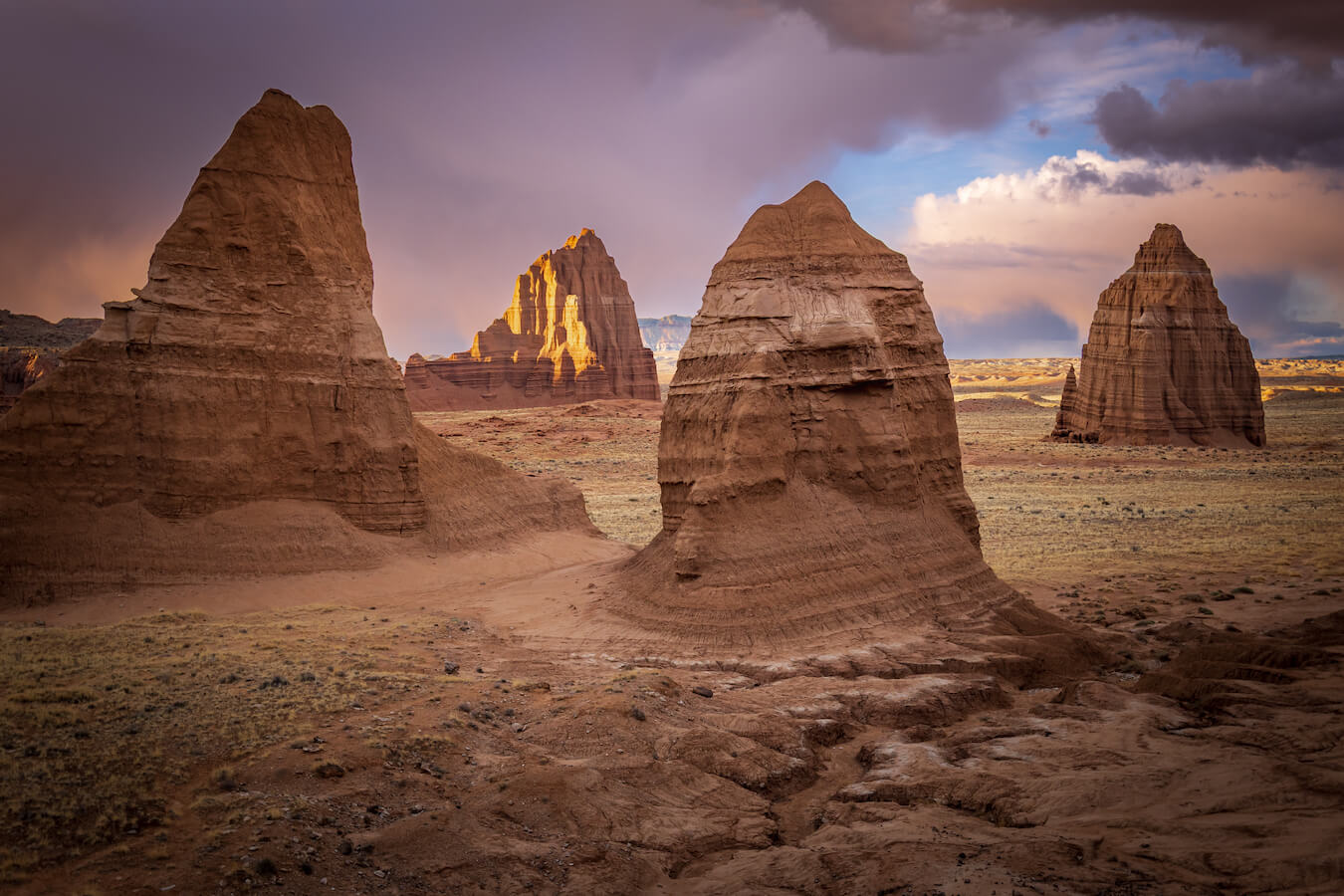
Find Your Favorite Location
No matter where you go in Capitol Reef National Park, be sure to take your time and find your favorite location along the way. If you are lucky, you may even spot some wildlife! Don’t forget to add detailed macro shots, change your perspective, and most importantly have fun.
Before making your trip, consider checking the official Capitol Reef National Park website or contacting the park’s visitor center for the most up-to-date information on trail conditions, accessibility, and any recent changes. As with any visit to a national park, it’s important to follow park regulations, practice “Leave No Trace” principles, and prioritize safety while exploring this beautiful area. I hope you enjoy your time photographing the Temples of the Sun, Moon, and Stars!
Happy Travels!
Juventa, Co-Owner, National Park Photographer
Want to learn more about Capitol Reef National Park? Check out these maps, guides & books:
- Capitol Reef National Park Map (National Geographic Trails Illustrated Map)
- Best Easy Day Hikes Capitol Reef National Park (Best Easy Day Hikes Series)
- Capitol Reef National Park: The Complete Hiking and Touring Guide
- The Capitol Reef Reader (National Park Readers)
- Photographing Arches, Canyonlands and Capitol Reef National Parks
Please note, by making purchases through our affiliate links, you are supporting our mission to celebrate and showcase our National Parks and the photographers who frequent them. As an Amazon Associate, National Park Photographer earns from qualifying purchases at not cost to you. We appreciate your support.
